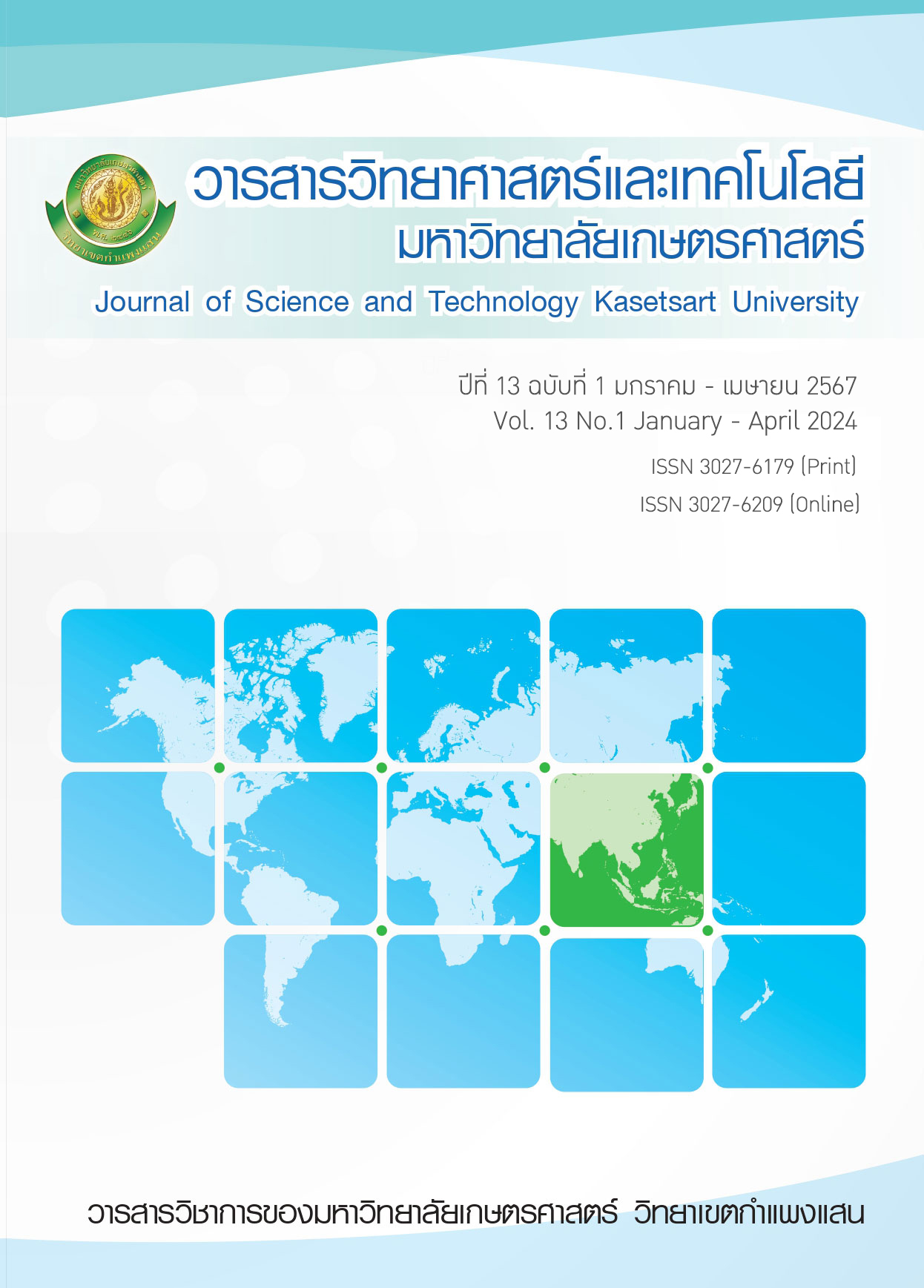Effects of Combined Chicken Protein Hydrolysate Supplementation and Concurrent Exercise Training on Body Composition and Lipid Profile in Overweight and Obese Adults
Main Article Content
Abstract
The purpose of this study was to investigate the effects of combined chicken protein hydrolysate supplementation and concurrent exercise training on body composition and lipid profile in overweight and obese adults. Thirty-four overweight or obese individuals (age: 47.62 ± 6.88 years old; body mass index (BMI): 28.45 ± 3.80 kg/m2) were assigned to three groups: a placebo control (CON, n=12), a chicken protein hydrolysate ingestion (20g in the form of crackers) (PRO, n=10), and combined concurrent training and chicken protein cracker ingestion (CBT-PRO, n=12). The CBT-PRO group performed combined exercise (body weight exercise; 2 sets, 12-15 reps/set and aerobic exercise; 65-75% HRR) 60 min/day, 3 days/week for 8 weeks. Body composition and lipid profile were measured before and after the intervention. The data were analyzed using mean, standard deviation, comparing differences within-group and between groups (p<0.05).
The results show all groups had no significant difference in body composition and lipid profile compared with baseline and between groups. Therefore, future studies should determine or regulate daily protein intake to ensure participants that they receive the appropriate amount of protein, including increasing the intensity of resistance exercise and increasing the duration of aerobic exercise.
Article Details
References
ทนงศักดิ์ ทองศรีสุข. (2564). การศึกษาขนาดอิทธิพลของโปรแกรมการออกกำลังกายแบบแอโรบิกมวยไทยต่อสมรรถภาพทางกายของนักศึกษาระดับปริญญาตรี มหาวิทยาลัยราชภัฏชัยภูมิ. วารสารวิชาการมหาวิทยาลัยราชภัฏศรีสะเกษ, 15(3), 74-87.
นงลักษณ์ วิรัชชัย. (2543). พรมแดนความรู้ด้านการวิจัยและสถิติ. ชลบุรี: วิทยาลัยการบริหารรัฐกิจ มหาวิทยาลัยบูรพา.
สำนักงานสถิติแห่งชาติ. (2560). สำรวจพฤติกรรมการบริโภคอาหารของประชากร พ.ศ. 2560. กรุงเทพฯ: สำนักงานสถิติแห่งชาติ
Babaei, A., & Nouri, M. (2022). Effects of whey protein on appetite: An overview with a mechanistic insight. Journal of Clinical Images and Medical Case Reports, 3, 1-4. doi: 10.52768/2766-7820/2065.
Batrakoulis, A., Jamurtas, A. Z., Metsios, G. S., Perivoliotis, K., Liguori, G., Feito, Y., Krustrup, P. (2022). Comparative efficacy of 5 exercise types on cardiometabolic health in overweight and obese adults: A systematic review and network
meta-analysis of 81 randomized controlled trials. Circulation: Cardiovascular Quality and Outcomes, 15(6), e008243.
doi: 10.1161/CIRCOUTCOMES.121.008243
Daliri, E. B.-M., Oh, D. H., & Lee, B. H. (2017). Bioactive peptides. Foods, 6(5), 1-21. doi: 10.3390/foods6050032.
Gannon, M. C., & Nuttall, F. Q. (2004). Effect of a high-protein, low-carbohydrate diet on blood glucose control in people with type 2 diabetes. Diabetes, 53(9), 2375-2382. doi: 10.2337/diabetes.53.9.2375.
Hassanzadeh-Rostami, Z., Abbasi, A., & Faghih, S. (2020). Effects of biscuit fortified with whey protein isolate and wheat bran on weight loss, energy intake, appetite score, and appetite regulating hormones among overweight or obese adults. Journal
of Functional Foods, 70, 103743. doi: 10.1016/j.jff.2019.103743.
Klomklorm, A., Ruangthai, R., Vaithanomsat, P., Sukatta, U., & Phoemsapthawee, J. (2020). Concurrent training and Eri silkworm pupae ingestion improve resting and exercise fat oxidation and energy expenditure in obese adults. Journal of exercise rehabilitation, 16(5), 467.
Liguori, G., & American College of Sports Medicine. (2020). ACSM's guidelines for exercise testing and prescription. Philadelphia: Lippincott Williams & Wilkins.
Marangoni, F., Corsello, G., Cricelli, C., Ferrara, N., Ghiselli, A., Lucchin, L., & Poli, A. (2015). Role of poultry meat in a balanced
diet aimed at maintaining health and wellbeing: an Italian consensus document. Food & nutrition research, 59, 27606. doi: 10.3402/fnr.v59.27606.
Moon, J., & Koh, G. (2020). Clinical evidence and mechanisms of high-protein diet-induced weight loss. Journal of obesity & metabolic syndrome, 29(3), 166. doi10.7570/jomes20028
Pesta, D. H., & Samuel, V. T. (2014). A high-protein diet for reducing body fat: mechanisms and possible caveats. Nutrition & metabolism, 11, 1-8. doi: 10.1186/1743-7075-11-53
Philippou, C., Andreou, E., Menelaou, N., Hajigeorgiou, P., & Papandreou, D. (2012). Effects of diet and exercise in 337 overweight/obese adults. Hippokratia, 16(1), 46.
Solomon, T. P., Sistrun, S. N., Krishnan, R. K., Del Aguila, L. F., Marchetti, C. M., O'Carroll, S. M., Kirwan, J. P. (2008). Exercise and diet enhance fat oxidation and reduce insulin resistance in older obese adults. Journal of Applied Physiology. 104(5). 1313-1319. doi: 10.1152/japplphysiol.00890.2007
Tan, S., Li, W., & Wang, J. (2012). Effects of six months of combined aerobic and resistance training for elderly patients with a long history of type 2 diabetes. Journal of sports science & medicine, 11(3), 495.
Theodorou, A. A., Panayiotou, G., Volaklis, K. A., Douda, H. T., Paschalis, V., Nikolaidis, M. G., Papadopoulos, I. (2016). Aerobic, resistance and combined training and detraining on body composition, muscle strength, lipid profile and inflammation in coronary artery disease patients. Research in sports medicine, 24(3), 171-184. doi: 10.1080/15438627.2016.1191488
Vogtschmidt, Y. D., Raben, A., Faber, I., de Wilde, C., Lovegrove, J. A., Givens, D. I., Soedamah-Muthu, S. S. (2021). Is protein the forgotten ingredient: Effects of higher compared to lower protein diets on cardiometabolic risk factors. A systematic review and meta-analysis of randomised controlled trials. Atherosclerosis, 328, 124-135. doi: 10.1016/j.atherosclerosis.2021.05.011
World Health Organization. (2021). Obesity and overweight. Retrieved September 21, 2022, from https://www.who.int/news-room/fact-sheets/detail/obesity-and-overweight
World Health Organization. (2022a). WHO European regional obesity report 2022: Geneva: World Health Organization.
World Health Organization. (2022b). World Obesity Day 2022 – Accelerating action to stop obesity. Retrieved December 2, 2022, from https://www.who.int/news/item/04-03-2022-world-obesity-day-2022-accelerating-action-to-stop-obesity


